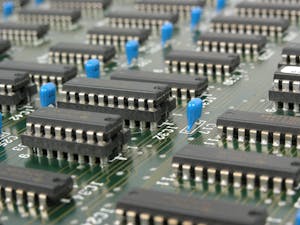I .C. (integrated circuit)
An integrated circuit (IC) is a small electronic device made of a semiconductor material, typically silicon, which contains a large number of tiny components, such as transistors, resistors, capacitors, and diodes, all embedded into a single chip. These components work together to perform various electronic functions.
### How an Integrated Circuit Works:
1. **Semiconductor Substrate**: The base of the IC is a semiconductor wafer, usually silicon, which can control electrical conductivity.
2. **Transistors**: The primary components within an IC are transistors, which act as switches or amplifiers. They control the flow of electrical current by turning it on or off or by amplifying it.
3. **Resistors and Capacitors**: These components regulate current and voltage levels within the IC, storing and releasing electrical energy as needed.
4. **Doping**: Silicon is doped with other elements to change its electrical properties, creating regions that are either conductive or non-conductive.
5. **Photolithography**: The process of etching patterns onto the silicon wafer using light. This process defines the intricate layout of the circuit components.
6. **Metal Interconnects**: Thin layers of metal are deposited to form connections between different components, allowing current to flow through the circuit in a specific manner.
7. **Packaging**: Once the IC is complete, it is encapsulated in a protective package that has external pins or connectors. These allow the IC to be integrated into larger electronic systems.
### Applications:
- **Microprocessors**: The brains of computers and many other electronic devices.
- **Memory Chips**: Used in computers, smartphones, and other devices to store data.
- **Analog Circuits**: Such as amplifiers and radio frequency circuits.
- **Digital Circuits**: Including logic gates, flip-flops, and microcontrollers.
### Functionality:
When integrated into an electronic device, an IC can perform various tasks, such as:
- **Processing Data**: In computers and smartphones.
- **Amplifying Signals**: In audio equipment.
- **Controlling Devices**: In embedded systems and industrial controls.
- **Communication**: In networking and telecommunication equipment.
The integration of many components into a single chip allows for higher performance, smaller size, lower power consumption, and reduced manufacturing costs compared to circuits made from discrete components.


Comments
Post a Comment